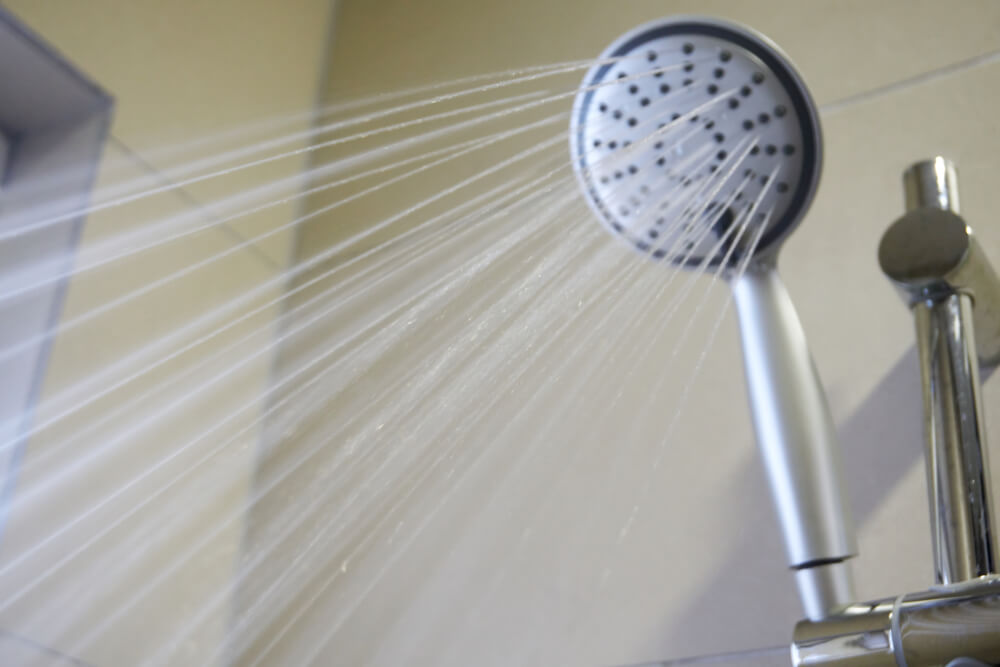Water not flowing from your shower head can be due to clogged nozzles or a faulty valve. Regular maintenance and timely repairs can prevent such issues.
Dealing with a shower head that won’t dispense water can be frustrating. This common problem often stems from blockages or plumbing mishaps. Homeowners should tackle this issue promptly to restore their daily routines. A clear, step-by-step guide can help diagnose and fix the cause of the obstruction.
Ensuring your shower is in top condition enhances your bathroom’s functionality and your overall home experience. Regular checks for mineral buildup and leaks can keep water flowing smoothly. Stay alert for signs of wear and tear to avoid unexpected shower malfunctions. With the right approach, you can quickly resolve any issues and enjoy uninterrupted shower time.

Credit: www.bossplumbing.com
Symptoms Of A Clogged Shower Head
Is your morning shower not as refreshing as it used to be? A clogged shower head might be the culprit. Over time, mineral deposits and debris can build up, leading to water flow issues. Recognizing the signs early can save you from a poor shower experience. Let’s explore the symptoms that indicate a clogged shower head.
Reduced Water Flow
Noticeable drop in water pressure? This is a telltale sign. When water struggles to make its way through the nozzles, it’s a clear indicator of clogging. If the water flow is not as strong as before, it’s time to check the shower head.
Sporadic Spraying
Another symptom to watch for is water spraying in odd directions. This can create an uneven spray pattern. It’s not only annoying but also a sign that your shower head needs attention. Mineral buildup often blocks certain nozzles, causing water to divert in various directions.
Identifying these symptoms early can help restore your shower to its full potential. Stay alert to these signs and take action to unclog your shower head promptly.
Common Causes Of Blockage
Shower heads can stop working well for many reasons. Let’s explore some common causes of blockage that might be affecting your shower experience.
Mineral Deposit Buildup
Hard water is full of minerals like calcium and magnesium. These minerals can stick to the inside of your shower head over time. This buildup can block water flow, making your shower less powerful. A sign of mineral deposit buildup is a white, chalky substance on your shower head.
- Sign: White, chalky substance
- Solution: Soak shower head in vinegar
Rust And Corrosion
Shower heads can also get rusty or corrode. This happens more in metal shower heads. Rust and corrosion can block water from coming out smoothly. If your shower head looks orange or has flakes coming off, it might be rust.
- Sign: Orange color or flaky texture
- Solution: Replace the shower head
Both mineral deposit buildup and rust can make your shower less enjoyable. Checking your shower head and cleaning it regularly can help. If the problem is too bad, you might need a new shower head.
Initial Checks Before Troubleshooting
Initial Checks Before Troubleshooting can save time. Imagine stepping into the shower only to find water is not coming out. Before calling a plumber, some simple checks might solve the issue.
Water Supply Issues
First, ensure the main water supply is on. Check other faucets in the home. If none have water, the issue might be with the main supply.
Valve And Faucet Inspection
Next, examine the shower valve. It controls water flow to the shower head. Make sure it is fully open. Also, inspect the faucet for any visible signs of damage.
- Check main water valve – Ensure it’s in the ‘on’ position.
- Inspect other water outlets – Are they working?
| Check | Action |
|---|---|
| Main Water Valve | Confirm it’s on |
| Other Outlets | Test for water flow |
- Shower Valve Position – It should be fully open.
- Faucet Condition – Look for cracks or damage.
Perform these checks first. They may quickly identify the problem. This can avoid unnecessary work and expense.
Simple Cleaning Techniques
Simple Cleaning Techniques can often restore your shower’s water flow. Mineral buildup and grime can clog the holes. Regular maintenance can prevent this. Let’s explore effective methods to clean your shower head.
Vinegar Soak Method
This method removes mineral deposits. White vinegar works best. Follow these steps:
- Fill a plastic bag with white vinegar.
- Submerge the shower head in the vinegar.
- Secure the bag with a tie or rubber band.
- Leave it overnight for best results.
- Rinse with water in the morning.
Manual Cleaning With A Brush
For surface grime, a brush can work wonders. Use a small brush like an old toothbrush. Gently scrub each nozzle. Warm water helps loosen debris. Rinse thoroughly afterward.
Advanced Cleaning Solutions
Is your shower head not releasing water properly? Don’t worry! Advanced cleaning solutions can help. These methods will make your shower feel new again.
Commercial Cleaners
Commercial cleaners are a quick fix. They remove buildup effectively. Always choose a cleaner designed for your shower head material. Follow the instructions carefully.
- Vinegar-based cleaners work well for mineral deposits.
- For heavy grime, a stronger chemical cleaner may be needed.
- Wear gloves to protect your hands.
Disassembling For Deep Clean
For a thorough clean, disassemble your shower head. This method reaches every nook.
- Turn off the water supply.
- Unscrew the shower head from the hose or wall.
- Soak the parts in a vinegar solution overnight.
- Use a small brush to scrub inside the jets and threads.
- Rinse well and reassemble.
This deep clean restores water flow and pressure. It also prevents future clogs.
Replacing Parts When Necessary
Replacing Parts When Necessary is a key step in ensuring a steady flow from your shower. Over time, shower heads can clog or wear out. This affects water pressure and quality. Knowing when and how to replace parts keeps showers functioning well.
When To Change The Shower Head
Several signs indicate the need for a new shower head:
- Reduced water pressure
- Irregular spray patterns
- Visible mineral deposits
- Leaks even after repairs
If these issues persist, consider a replacement.
Choosing The Right Replacement
Selecting a new shower head involves several factors:
| Type | Features | Installation |
|---|---|---|
| Fixed or handheld | Adjustable settings | Tool-free options |
| High or low pressure | Water-saving technology | Compatibility with existing system |
Match the new part to your shower’s specs for the best fit.
Preventive Measures For Long-term Maintenance
Preventive Measures for Long-Term Maintenance ensure a steady flow from your shower head. Regular upkeep avoids clogs and wear. Let’s explore practical steps to maintain your shower’s performance.
Regular Cleaning Routine
Build-up from water minerals can block shower heads. A simple cleaning routine prevents this. Here’s a step-by-step guide:
- Detach the shower head monthly.
- Soak it in vinegar overnight.
- Rinse with water to clear residue.
- Re-attach and enjoy a strong flow.
Consistent cleaning extends your shower head’s life.
Water Softeners And Filters
Hard water damages shower heads. It leaves limescale and mineral deposits. Softeners and filters can help:
| Device | Benefit |
|---|---|
| Water Softener | Reduces mineral content in water. |
| Filter | Traps sediments before they reach the shower. |
Installing these devices keeps water clean. This prevents blockages and maintains a steady stream.

Credit: blog.expertsinyourhome.com
Professional Help Vs. Diy
Encountering a shower with no water can frustrate anyone. Should you fix it yourself or call a professional? This choice often depends on the issue’s complexity and the homeowner’s skill level.
Professional Help vs. DIY — a dilemma many face when their shower betrays them. Each option has pros and cons, which we’ll explore.
When To Call A Plumber
Some shower problems need expert hands. Look for these signs:
- Complex Issues: Low pressure might be due to municipal supply problems.
- Hidden Leaks: Water stains on walls suggest hidden leaks.
- Old Pipes: Aged pipes might need a complete overhaul.
Plumbers can diagnose and fix these expert-level problems quickly.
Cost-benefit Analysis
Compare costs and benefits of DIY vs. professional repair.
| DIY Repair | Professional Repair |
|---|---|
|
|
Weigh the immediate and long-term effects of both options. Your skills, time, and budget play key roles.

Credit: www.rusco.com
Frequently Asked Questions
Why Is My Shower Head Not Flowing?
A clogged nozzle or a faulty diverter valve often causes low water flow from shower heads.
Can A Shower Head Lose Pressure?
Yes, shower heads can lose pressure over time due to mineral buildup or pipe issues.
How Do I Clean A Blocked Shower Head?
Soak the shower head in a mixture of vinegar and water to dissolve mineral deposits that block the nozzles.
What Causes Sudden Shower Pressure Drop?
A sudden pressure drop can be due to a closed shut-off valve, a kinked hose, or a malfunctioning water heater.
Is Replacing A Shower Head A Simple Fix?
Replacing a shower head is typically a straightforward DIY task that requires minimal tools and time.
Conclusion
Dealing with a shower head that won’t dispense water can be frustrating. Yet, with the right approach, it’s a solvable issue. Ensure regular maintenance, check for clogs, and consider professional help if needed. Remember, a fully functional shower enhances your daily routine, making it worth the effort to fix.

